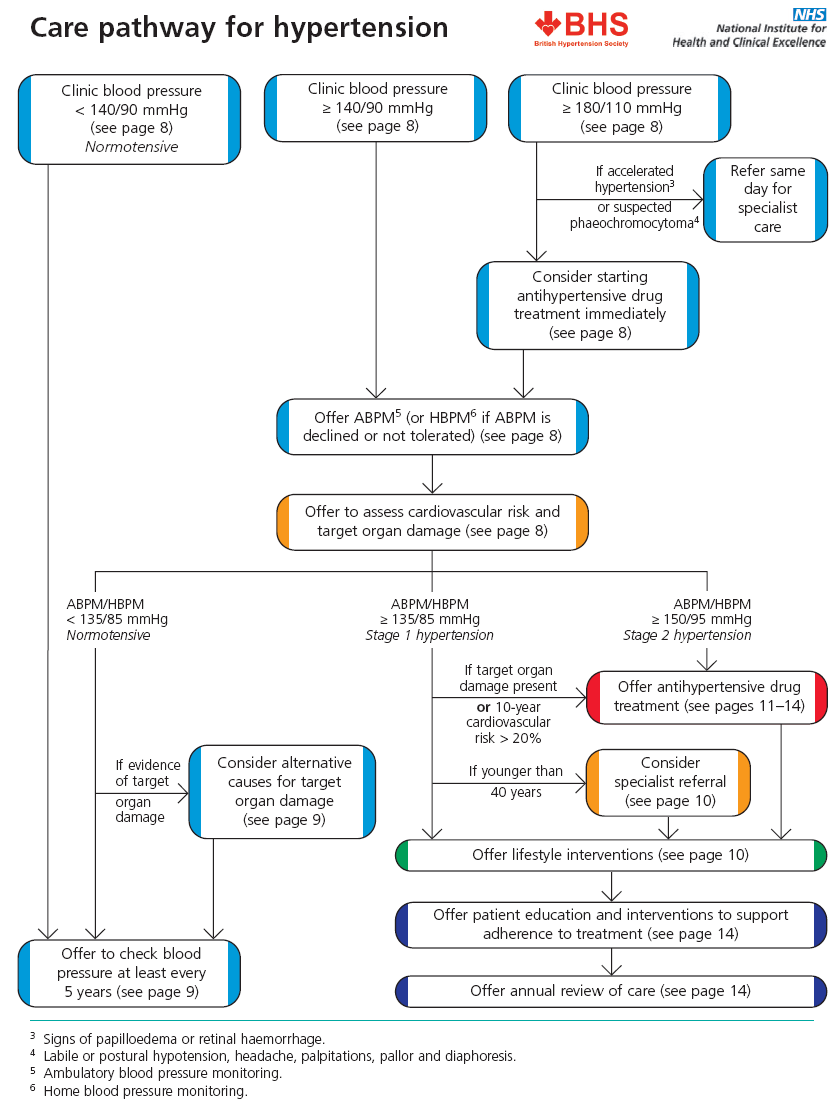Mark sees the practice nurse and she checks his BP again. She confirms his high reading and finds it to be 173/105.
If you need more information on Ambulatory Blood Pressure Monitoring (ABPM) and Home Blood Pressure Monitoring (HBPM), please review Moudle 1. Please see Additional information for the British and Irish Hypertension Society (BIHS) pathway.
Given the results of Mark’s BP, what action would you take?
Pictorial rollover
- ABPM: High blood pressure very rarely has any symptoms. Measuring someone’s blood pressure is the only way to know what it is. ABPM provides a full 24-hour profile of someone’s blood pressure.
If ABPM is declined, not tolerated or unavailable, then home blood pressure monitoring is an alternative (using the NICE guidance: Hypertension 2011). - U&Es: Urea levels help to monitor how the kidneys are working.
Electrolytes (e.g. sodium, potassium) and minerals (e.g. calcium) help to stabilise the heart rhythm, so changes in these levels may require further investigations.
Baseline results are useful for future clinical management. - LFTs: Liver function tests (LFTs) measure various chemicals in the blood made by the liver. An abnormal result may indicate a problem in the liver or other organs. Further tests may be needed to clarify the abnormality identified.
Baseline results are useful for future clinical management. - Cholesterol: Cholesterol is produced naturally within the body, mainly in the liver. Excess saturated fat in the diet increases blood cholesterol. The normal level is below 5mmol/l. It includes LDL (low-density lipoprotein), known as “bad cholesterol”, which carries cholesterol from the liver to the tissues around the body and HDL (high-density lipoprotein), known as “good cholesterol” because it carries surplus cholesterol from the tissues back to the liver to be recycled or excreted.
Baseline results are useful for future clinical management. - Glucose: This test measures the level of glucose (sugar) in the blood. If this greater or equal to 6mmol/l, further investigation may be required to determine the cause.
Baseline results are useful for future clinical management. - Urine test: A urine sample, checked with a dip stick, can diagnose or rule out health conditions. Urine contains waste products that are filtered out of the body. If the urine contains anything unusual, this may indicate an underlying health problem. For example, a high level of glucose (sugar) in the urine may be a sign of type 2 diabetes. A urine sample can aslo indicate a urinary tract infection (UTI) or kidney problems.
In hypertension, a urine test can also demonstrate protein (or blood) which may influence a decision to investigate or treat. - ECG (monitor): The purpose of recording an ECG is to help in the identification of abnormalities associated with hypertension. i.e., Left Ventricular Hypertrophy (LVH).
- EGFR (blood tubes): Estimated Glomerular Filtration Rate is usually based on serum Creatinine level, age, sex, and race. Creatinine is the most efficient routine blood test for measuring how well kidneys are working. As this is a waste product produced by muscles and put out through the kidneys it means that the “normal” levels depend on how much muscle an individual has. More information is available at The Renal Association: the professional body for UK nephrologists.
Baseline results are useful for future clinical management.
Pulse point
NICE clinical guideline 127 [.pdf]
The British & Irish Hypertension Society website explains more about blood tests and other investigations in relation to hypertension management.
Page last reviewed: 26 May 2020



